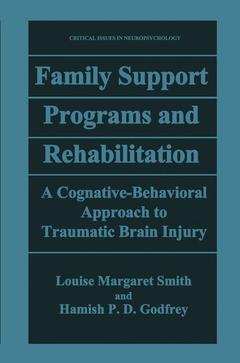Description
Family Support Programs and Rehabilitation, Softcover reprint of the original 1st ed. 1995
A Cognitive-Behavioral Approach to Traumatic Brain Injury
Critical Issues in Neuropsychology Series
Authors: Smith Louise Margaret, Godfrey Hamish P. D.
Language: English
Subjects for Family Support Programs and Rehabilitation:
Keywords
brain; emotion; rehabilitation; trauma; traumatic brain injury
158.24 €
In Print (Delivery period: 15 days).
Add to cart
Publication date: 05-2013
222 p. · 15.5x23.5 cm · Paperback
222 p. · 15.5x23.5 cm · Paperback
Description
/li>Contents
/li>
The permanent effects of traumatic brain injury (TBI) are not limited to the person who suffers the injury. People who care for the individual, particularly family members, suffer in various ways. Family members are often confused as to the behavioral and neuropsychological changes that they see in a brain-injured rela tive. They can become frustrated and angry when the individual does not return to premorbid levels of functioning. They can become tired and worn down from repeated problems in trying to manage the individual's difficulties while having only fragmented information regarding them. Drs. Smith and Godfrey have provided a useful service for family members by summarizing important neuropsychological changes associated with TBI and providing practical guidelines for coping with these problems. While the neuropsychological problems they describe are not completely understood, the authors provide a useful description of many of the neuro behavioral problems seen following TBI in young adults. They attempt to provide guidelines for family members that have practical utility in understanding and managing these patients. Theirs is a cognitive-behavioral approach that can have utility for this group of individuals. I applaud their efforts to provide something systematic and practical for family members.
1. Psychosocial Effects of Traumatic Brain Injury.- 2. Approaches to Rehabilitation Following Traumatic Brain Injury.- 3. Compensating for Cognitive Impairment.- 4. Enhancing Emotional Adjustment.- 5. Improving Social Competency.- 6. Fostering Family Adaptation.- 7. Evaluation of Outcome Effects.- 8. Summary and Conclusions.- Appendixes.- A. What Happens after a Traumatic Brain Injury?.- B. Profile of Functional Impairment in Communication (PFIC).- C. Summary of Intervention Strategies.- D. Case-by-Case Matching.- E. Head Injury Behavior Scale.- F. Results of the Consumer Satisfaction Questionnaire.- G. Case Management Assessment Areas.- References.
© 2024 LAVOISIER S.A.S.




